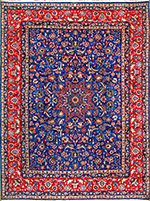Textiles Studies

Textile Research Works
Date of this Version
2004
Document Type
Article
Citation
Bier, C. (2001). Mathematical aspects of Oriental carpets [Special issue of Symmetry: Culture and Science]. Symmetry in Ethnomathematics, 12(1-2), 67-77. Budapest, Hungary: International Symmetry Foundation.
Abstract
When one looks at an Oriental carpet in the context of Western art, one usually perceives a richness of colors and patterns, and perhaps the contrast between central field and surrounding borders. A careful observer might notice the appearance of superimposed plane patterns in the central field and multiple linear patterns in the surrounding borders. Each of patterns, whether in the field or the borders, is composed of various design elements, which in combination are repeated according to the principles of symmetry, often with the addition of symmetry-breaking (Bier 1992, 1997, 1998, 2000a). The mathematical principles of pattern making according to symmetrical repetition are well-known today, but the mathematical aspects of pattern formation have been glossed over in the study of Oriental carpets, or neglected in favor of either an appreciation of color and form or a discussion of social and ethnic origins. This article seeks to address several mathematical aspects of Oriental carpets, which are both integral to their form and manifest in their visual make-up.
Included in
Art and Materials Conservation Commons, Art Practice Commons, Fiber, Textile, and Weaving Arts Commons, Indigenous Studies Commons, Museum Studies Commons


Comments
© Symmetry Foundation.